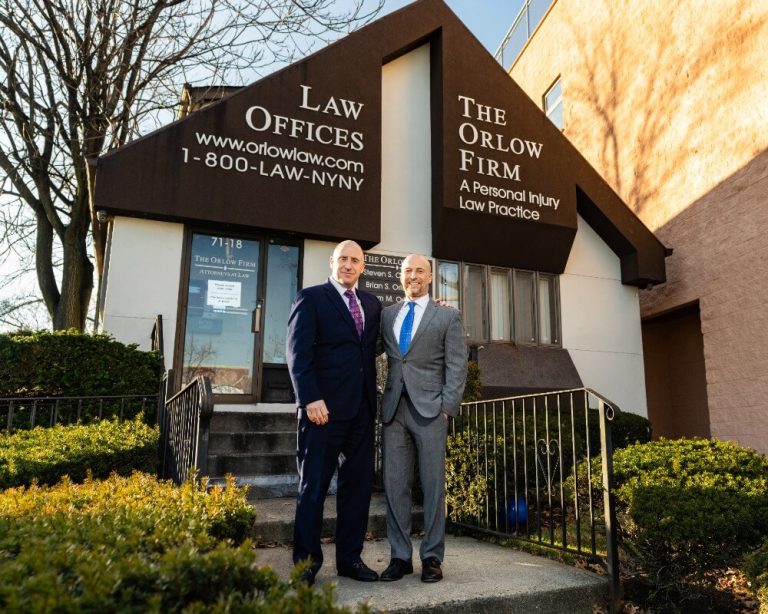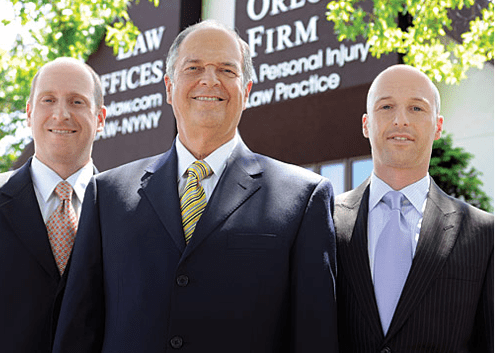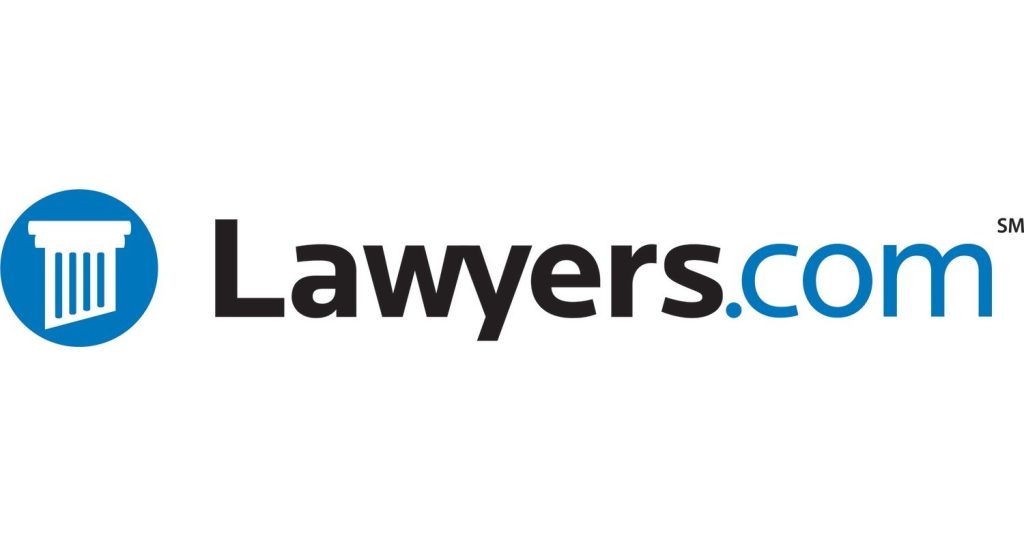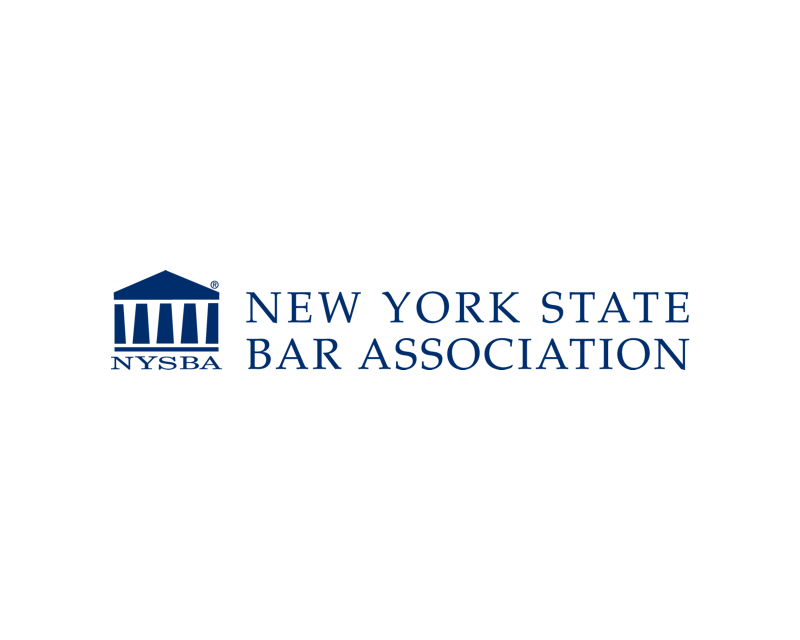The Following People Contributed to This Page
Cindy Cordova is a seasoned legal writer with over seven years of experience crafting clear, informative, and professional content for law firm websites. With a B.A. in English from Trinity Christian College, she combines her strong writing background with a deep understanding of legal topics to help firms connect with their clients through trustworthy and accessible content.
- August 9, 2025
Can I Still Get Compensation if I Was Partly at Fault?
Quick Answer: In New York, the law does not follow strict contributory negligence. Instead, the state uses a “pure comparative negligence” rule, meaning you can still recover compensation even if you were partly at fault for your injury, though your payout will be reduced by your percentage of blame. If you have questions about shared fault in your NYC injury claim, contact The Orlow Firm for guidance at (646) 647-3398.
Attorney Advertising Disclaimer: This content is for informational purposes only and does not constitute legal advice. No attorney-client relationship is formed by reading this content or contacting the firm. Prior results do not guarantee a similar outcome.
What is Contributory Negligence and Does New York Use It?
Contributory negligence is a legal concept used when more than one person shares blame for an accident or injury. In New York, however, the law does not follow strict contributory negligence rules. Instead, New York uses a system called comparative negligence. While related, these are not the same.
Under traditional contributory negligence laws, if you were even slightly at fault—say just 1%—you could be barred from getting any compensation. Thankfully, New York does not follow this harsh rule. But the idea of shared fault, or that a victim’s actions may have contributed to their injury, still plays a role in the legal process.
In New York City, if you are injured and someone else is mostly to blame, you can still file a personal injury claim—even if you also made a mistake. This often comes up in situations like:
- Slip and fall accidents occurred where warning signs were posted, but not clearly visible
- Car accidents where both drivers were speeding slightly
- Construction site injuries where safety gear was not fully used
For example, imagine a construction worker in Brooklyn is injured because a scaffold was not properly secured. But that worker also failed to use a safety harness. The insurance company may argue that the worker shares some blame. In this case, the court would look at both sides before deciding how much compensation the worker can receive. A qualified NYC construction accident lawyer can help explain how this legal principle may apply to your case.
In short, while New York technically allows claims even when the injured person is partly at fault, that shared responsibility—known as contributory or comparative negligence—can lower the amount of compensation you receive. It’s important to understand how this might affect your case and to speak with a lawyer if the other side blames you.
How Does Contributory Negligence Differ from Comparative Negligence?
While people often use the terms “contributory negligence” and “comparative negligence” as if they mean the same thing, they are actually very different. Each rule affects how much money an injured person can recover in a personal injury case. The key difference lies in how fault is shared and how that affects compensation.
Contributory negligence is a legal rule that says if a person is even a little bit at fault for their own injury, they cannot get any compensation. For example, if someone is found to be 1% at fault for an accident, they might not receive any money at all under this rule. Only a few states still use this system. New York does not follow this rule.
Comparative negligence, on the other hand, allows for shared fault. In New York, this is the system that’s used. It means that even if you are partly at fault for your injuries, you may still be able to recover some money. But the amount you can get will be reduced by the percentage of your own fault.
Here’s how New York’s comparative negligence rule works in practice:
- You’re 20% at fault: You were texting when you slipped on a wet floor in a store. A jury finds you 20% at fault for not paying attention. You can still recover 80% of your damages.
- You’re 50% at fault: You and a driver both make errors in a car crash. You can still recover 50% of your losses.
- You’re 90% at fault: You may still recover 10% of your damages, depending on the total amount and the details of the case.
New York uses what’s called “pure” comparative negligence. This means there’s no fault limit that blocks you from getting compensation, as long as someone else also played a part in causing the accident.
Understanding the difference between contributory and comparative negligence is important because it directly affects your rights. In states with contributory negligence, even small mistakes by the injured person could block all recovery. But in New York, the law gives injured people a fairer chance to recover, even if they were partly responsible.
If you were hurt in an accident in New York City and the other side is blaming you, knowing how fault is shared under the law is critical. To understand how this may affect your specific case, call The Orlow Firm at (646) 647-3398 for a free consultation.
Can You Still Get Compensation If You Were Partly at Fault in NYC?
Yes, in New York City, you can still receive compensation even if you were partly at fault for an accident. This is because New York follows a law called comparative negligence, not contributory negligence.
Comparative negligence means that the court or insurance company looks at how much each person involved is to blame. Then, the amount of money you can receive is reduced by your percentage of fault.
For example:
- If you are found 20% at fault in an accident and your total damages are $100,000, you could still receive $80,000 (which is 80% of the total).
- If you are 50% at fault, you could still get $50,000.
- Even if you are 90% at fault, you may still receive 10% of your damages.
This is very different from contributory negligence, which is used in some other states. Under that rule, if you were even just 1% at fault, you wouldn’t be allowed to recover any money. Luckily, New York does not follow that rule.
However, insurance companies often try to use shared fault to reduce your settlement. That’s why it’s important to gather evidence and speak with someone who can help you protect your rights.
Here are some tips if you think you may be partly at fault:
- Don’t admit fault at the scene. Even saying “I’m sorry” can be used against you later.
- Get medical help right away. This helps document your injuries.
- Take photos and gather witness names if possible. They may support your side of the story.
If someone else’s carelessness helped cause your injury, even if you also made a mistake, you may still get compensation. The key is showing how much of the accident was caused by the other party.
To learn more about how fault might affect your case, or to discuss your options, contact The Orlow Firm at (646) 647-3398. We offer free consultations and are here to help guide you through every step.
How Is Fault Determined in New York Personal Injury Cases?
In New York personal injury cases, fault is not always clear-cut. Determining who is legally responsible—also known as “at fault”—is a key part of figuring out whether someone can get compensation and how much they can recover. New York follows a rule called “comparative negligence,” which means more than one person can share blame for an accident.
To decide fault, insurance companies, attorneys, and sometimes the courts look at all the facts and evidence. They ask questions like: Who acted carelessly? Did anyone break a law or safety rule? Was someone not paying attention when they should have been?
Here are some of the main ways fault is evaluated in a personal injury case in New York City:
- Accident reports: Police reports or incident reports can provide details about how the injury happened and may say who was at fault.
- Witness statements: People who saw the accident may be asked to explain what they saw. Their stories can help back up or challenge other evidence.
- Photos and videos: Pictures from the scene, surveillance footage, or dash cam videos can help show what really happened.
- Expert opinions: In complex cases, professionals like accident reconstruction experts or engineers may be brought in to explain who likely caused the accident.
- Your own actions: If you were partly responsible for your injury, that gets considered too. For example, if you were texting while walking and got hit by a car, your distraction may reduce your compensation.
Even if you’re partly at fault, New York law still allows you to get compensation. Your amount of fault will simply reduce the money you receive. For example, if you are found to be 20% at fault, your compensation will be reduced by 20%.
This process can be even more complicated in a big city like New York, where streets are busy and many people can be involved in the same accident. That’s why having accurate evidence and strong legal support is so important.
Attorney Advertising Disclaimer: This content is for informational purposes only and does not constitute legal advice. No attorney-client relationship is formed by reading this content or contacting the firm. Prior results do not guarantee a similar outcome.
If the fault is disputed or the insurance company is blaming you unfairly, it may affect your case. In these situations, talking with a personal injury attorney can help protect your rights. For help with your NYC injury case, contact The Orlow Firm at (646) 647-3398 for a free consultation.
What Types of Cases Commonly Involve Contributory Negligence?
Contributory negligence can come up in many types of personal injury cases. In New York City, where life moves fast and accidents happen often, it’s important to know when this concept might apply. Simply put, contributory negligence means the injured person may have played a part in causing their own injuries. This doesn’t automatically prevent someone from getting compensation, but it can affect the amount they receive.
Here are some common types of cases in NYC where contributory negligence may be an issue:
- Car Accidents: If a driver wasn’t following traffic rules, but the injured person was also texting while walking, both could be found partly at fault.
- Pedestrian Accidents: A pedestrian who crosses the street without the signal and is hit by a car may share some fault, even if the driver was speeding.
- Slip and Fall Cases: If someone slips on a wet floor but wasn’t watching where they were walking, the property owner might argue the person was partly responsible.
- Construction Accidents: Workers injured on the job might be blamed for not following safety rules, even if the site was unsafe overall.
- Bicycle or Scooter Accidents: If a cyclist is hit by a car but wasn’t using a bike lane or wearing lights at night, they could be found partially at fault.
- Dog Bites: If a person approaches a dog after being warned not to, it could reduce the dog owner’s liability.
In each of these cases, the injured person’s actions are looked at closely. Courts want to know if the person could have avoided the injury or acted differently. This is important because, under New York’s laws, your compensation can be lowered if you are partly at fault.
If the other side claims you were negligent too, it doesn’t mean you don’t have a case. But it does mean you’ll need to show how the other party’s actions were more serious. These cases can be complex, and each situation is different. If you’re unsure whether fault could affect your case, it can help to speak with a personal injury attorney in NYC. You can call The Orlow Firm at (646) 647-3398 for a free consultation to discuss your options.
How Can Contributory Negligence Affect Your Settlement Amount?
In New York City, if you were partly responsible for an accident, it could lower the amount of money you receive in a personal injury settlement. This is where the idea of contributory negligence comes in. However, New York does not follow strict contributory negligence rules. Instead, the state uses a system called pure comparative negligence.
Under this system, you can still get compensation even if you were mostly at fault—up to 99%. But the total amount you receive will be reduced based on your share of fault.
Here’s how it works:
- Let’s say your case is worth $100,000 if you were not at fault at all.
- If you are found to be 30% at fault, your settlement would be reduced by 30%.
- You would then receive $70,000 instead of the full $100,000.
Insurance companies often try to argue that you hold some share of the blame. This can be a tactic to lower the amount they pay you. For example, if you slipped on a wet floor while looking at your phone, the other side might argue that you’re partly responsible for the fall.
Being blamed for part of an accident does not mean you lose your rights. But it does mean your total award could go down. That’s why it’s important to understand how fault is decided and what evidence can help reduce your share of blame.
If you’ve been injured in New York City and someone is saying you were partly at fault, it’s important to talk to someone familiar with the law. Call The Orlow Firm at (646) 647-3398 to discuss your situation and learn about your options. We’re here to help you understand how contributory negligence may affect your compensation.
What Should You Do If the Other Side Claims You Were Negligent?
If the other side says you were partly or fully at fault for your accident, don’t panic. This is a common tactic used by insurance companies or defense lawyers to reduce or avoid paying compensation. What you do next can impact your case and your ability to recover damages.
Here are important steps to take if you’re being blamed for your own injuries in a New York City personal injury case:
- Stay calm and avoid admitting fault: After an accident, it’s normal to want to explain what happened. But even a simple “I’m sorry” can be used against you. Avoid making any statements that could be seen as taking the blame.
- Gather and save evidence: Try to collect any evidence that supports your side. This includes photos, videos, witness names, accident reports, and medical records. The more facts you have, the stronger your case may be.
- Write down your version of events: As soon as possible, record what happened before, during, and after the accident. Include details like time, location, weather, and road or property conditions. Memories fade quickly, so writing them down early helps.
- Avoid discussing your case on social media: Insurance companies may look at your posts to find anything they can use to blame you or lower your compensation. It’s best to stay off social platforms while your case is active.
- Do not sign anything without legal advice: You may be asked to sign documents or give a recorded statement. These might hurt your case if you’re not careful. Always check with a personal injury lawyer first.
New York uses a rule called “comparative negligence.” This means you can still get compensation even if you were partly at fault. However, your payment will be reduced by your share of the blame. For example, if you were found 20% at fault, you could still recover 80% of your damages.
If someone else claims you were negligent, it’s important to protect yourself by speaking with a lawyer. A skilled attorney can help gather evidence, work with accident experts, and argue against unfair blame. This can make a significant difference in the amount of compensation you may receive.
If you’re being blamed for your injuries in a New York City accident, call The Orlow Firm at (646) 647-3398 to discuss your case. Your consultation is free and confidential.
Attorney Advertising Disclaimer: This content is for informational purposes only and does not constitute legal advice. No attorney-client relationship is formed by reading this content or contacting the firm. Prior results do not guarantee a similar outcome.
When Should You Talk to a Personal Injury Lawyer in NYC About Fault?
If you’ve been injured in an accident in New York City and the question of fault comes up, it’s often a good time to talk to a personal injury lawyer. Fault plays a big role in how much compensation you may receive. Even if you think you were partly responsible, you may still be able to recover money. That’s why getting legal advice early can make a big difference.
Here are some times when you should strongly consider calling a lawyer about fault in your accident:
- The other party blames you: If the other side claims you caused the accident, talking to a lawyer can help protect your rights and prepare your response.
- You may share some responsibility: If you think you might be partly at fault—for example, if you were distracted or didn’t follow a rule—you should speak with a lawyer to understand how that might affect your claim.
- Insurance denies or reduces your payment: Sometimes insurance companies use claims of shared fault to lower your payout. A lawyer can help challenge that.
- The facts of the accident are not clear: If it’s not obvious who caused the accident, an attorney can help gather evidence, speak to witnesses, and figure out the details.
- You suffered serious injuries: If your injuries are more than just minor scrapes or bruises, a lawyer can help make sure you’re not unfairly blamed and that you get the full compensation you need to recover.
In New York, the law follows “comparative negligence.” This means you can still get compensation even if you were partly at fault—but the amount may be reduced. For example, if you were 20% responsible, your payment could be cut by 20%. Understanding how this works is important, and a lawyer can explain what it means in your case.
Fault can be especially tricky in crowded places like NYC, where accidents often happen fast and in busy areas—like crosswalks, subway stations, or construction zones. A personal injury lawyer with experience in New York City can help sort through the facts and make sure your side of the story is heard.
If someone is blaming you, or if you’re simply not sure what happened, it’s smart to ask for professional guidance. The sooner you speak with a lawyer, the better your chances of building a strong case. To speak with a compassionate and knowledgeable attorney about your situation, call The Orlow Firm at (646) 647-3398 for a free, confidential consultation.
Attorney Advertising Disclaimer: This content is for informational purposes only and does not constitute legal advice. No attorney-client relationship is formed by reading this content or contacting the firm. Prior results do not guarantee a similar outcome.
Frequently Asked Questions About Contributory Negligence in New York
Here are some of the most frequently asked questions about contributory negligence in New York personal injury cases. These answers can help you better understand how fault might affect your right to compensation in New York City.
- Does New York follow contributory negligence rules? No. New York does not use contributory negligence. Instead, it follows a rule called “pure comparative negligence.” This means you can still recover money even if you were partly at fault for your injury.
- What’s the difference between comparative and contributory negligence? Under contributory negligence, if you are even 1% at fault, you could lose the right to any compensation. New York’s comparative negligence system is fairer to injured people. Even if you’re 90% at fault, you can still recover 10% of your damages.
- Can my damages be reduced if I was partly at fault? Yes. In New York, your final compensation will be reduced by the percentage of fault assigned to you. So if the total damages are $100,000 and you’re found to be 25% at fault, you may receive $75,000.
- Who decides how much each person is at fault? Fault is usually decided during settlement talks, by a judge, or by a jury if your case goes to trial. They will look at the evidence—such as accident reports, witness statements, or expert opinions—to decide how much blame each party shares.
- What happens if both parties are equally at fault? If you and the other person are each 50% at fault, your damages will be cut in half. You can still recover some money if you were injured, even though you share the blame.
- How do insurance companies use contributory or comparative negligence? Insurance companies may argue that your actions helped cause the accident, hoping to reduce what they pay. If this happens, it’s important to have legal help to challenge unfair blame and protect your rights.
- Can contributory negligence apply in slip and fall or construction site accidents in NYC? Yes. Any personal injury case in New York—including slip and falls, pedestrian accidents, construction injuries, or car crashes—may involve shared blame. Pure comparative negligence will determine how much compensation you may receive.
- Should I admit fault at the accident scene? It’s best not to admit fault right away, especially without knowing all the facts. What initially feels like your fault might not be, especially if other parties were careless or broke safety rules.
- Do I need a lawyer if contributory negligence is being used against me? It’s a good idea to talk to a lawyer if someone claims you were at fault. A lawyer can help gather evidence, speak with witnesses, and deal with insurance companies. This can help protect the value of your injury claim.
If you have more questions about how fault can affect your case in New York City, The Orlow Firm is here to help. Call us for a free consultation at (646) 647-3398.
Contact The Orlow Firm for a Free Consultation About Your NYC Injury Case

If you were injured in New York City and someone else says you were also partly at fault, you may still be able to recover compensation. These kinds of cases often involve a legal concept called contributory negligence. Understanding your rights can be confusing, especially when insurance companies use fault as a reason to lower or deny your claim.
At The Orlow Firm, we help injury victims understand how fault is judged in New York and what that means for their case. Our team can review the facts, gather evidence, and speak with insurance companies on your behalf. If the other side tries to blame you, we work to protect your right to fair compensation.
Common questions we help answer include:
- Can I still get money for my injuries if I made a mistake too? Yes, under New York law, you may be able to recover damages even if you were partly at fault.
- How is my share of fault decided? Each case is different, but we look at police reports, witness statements, and all the evidence to argue your side.
- Will my settlement be lower if I was partly responsible? It could be reduced based on your percentage of fault, but we aim to keep that number as low as possible.
No two injury cases are the same. Whether you were injured in a car crash, a slip and fall, or a construction site accident, the issue of fault can greatly affect the outcome. That’s why it’s important to talk with someone who understands how New York courts and insurance companies handle contributory and comparative negligence.
Taking the right steps early can make a big difference. If an insurance company is questioning your actions or suggesting you were to blame, don’t face it alone. You deserve to understand your legal options and what compensation may still be available to you.
Call The Orlow Firm at (646) 647-3398 for a free, confidential consultation. There is no pressure and no obligation. We’re here to listen, answer your questions clearly, and help you move forward with confidence.
Attorney Advertising Disclaimer: This content is for informational purposes only and does not constitute legal advice. No attorney-client relationship is formed by reading this content or contacting the firm. Prior results do not guarantee a similar outcome.
The Following People Contributed to This Page
Cindy Cordova is a seasoned legal writer with over seven years of experience crafting clear, informative, and professional content for law firm websites. With a B.A. in English from Trinity Christian College, she combines her strong writing background with a deep understanding of legal topics to help firms connect with their clients through trustworthy and accessible content.










